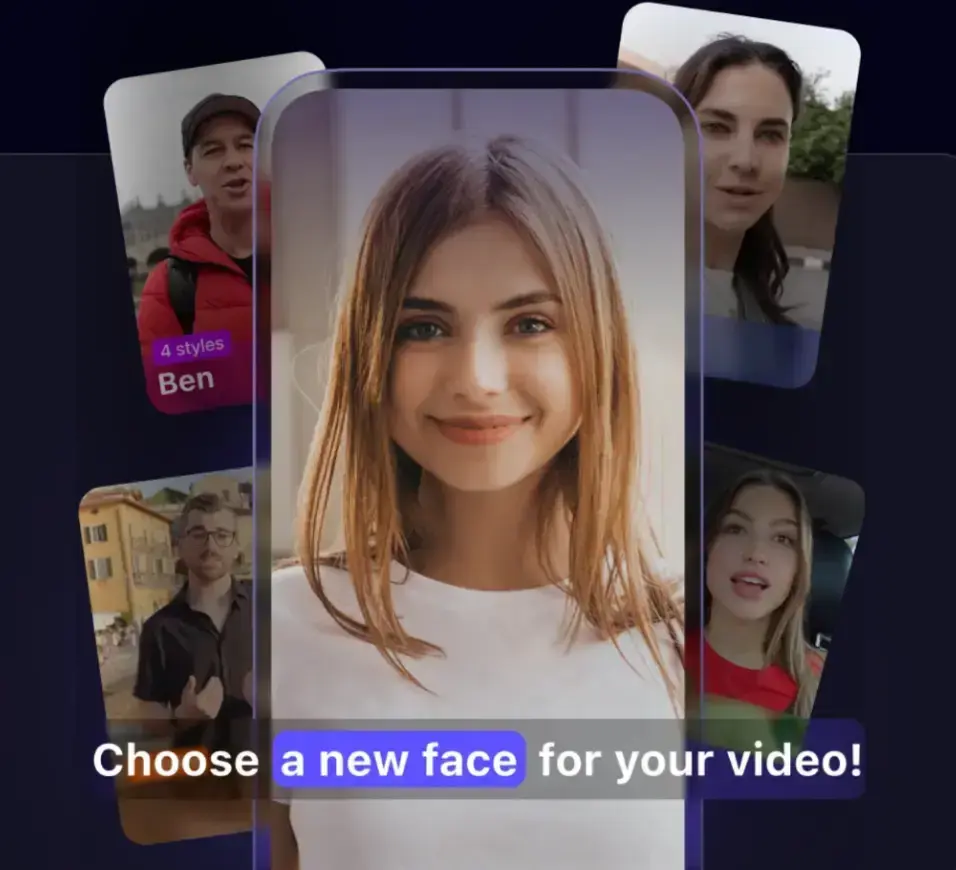The technological leap from basic 2D avatars to AI-driven digital humans has transformed how we express ourselves online.
In 2025, these virtual representations aren't just convenient digital stand-ins – they've become meaningful extensions of our personal identity, blurring the boundaries between the physical and the digital.
With an estimated $50 billion virtual economy surrounding avatar customization, the industry is booming. Today's avatars feature unprecedented realism, emotional intelligence, and adaptive capabilities across platforms.
As we move further into 2025, you'll see avatars become increasingly lifelike, respond to emotional cues, and play central roles in AR and VR environments.
Whether you're using them for professional meetings, gaming, or social media, staying ahead of these trends will enhance your digital presence and connections.
In this article:
- Why AI Avatar Trends Are More Relevant Than Ever
- Top AI Avatar Trends for 2025
What Are AI Avatars?

AI avatars are digital representations of individuals powered by artificial intelligence, capable of mimicking human appearance, behavior, and interactions.
Unlike traditional static avatars, AI avatars leverage deep learning models, neural networks, and generative adversarial networks (GANs) to create highly personalized digital identities with realistic features, expressions, and movements.
These intelligent digital personas have evolved dramatically from the pixelated figures of early video games to sophisticated digital humans capable of adapting to different contexts.
Modern AI avatars incorporate advanced behavioral patterns, emotional intelligence, and adaptive learning capabilities that respond to user inputs and environmental cues.
They're not merely visual representations but interactive entities that can recognize emotional cues, provide personalized responses, and maintain contextual awareness across various digital platforms.
The technology behind these avatars continues to advance, with major tech companies investing heavily in their development.
The virtual economy surrounding avatar customization has expanded to approximately $50 billion, with users investing in digital clothing, accessories, and features to enhance their online presence.
In professional settings, AI avatars provide 24/7 customer assistance, facilitate virtual meetings, and create personalized learning experiences.
For personal use, they enable unique self-expression across social media interactions, gaming platforms, and immersive virtual environments, creating more engaging digital interactions.
Why AI Avatar Trends Are More Relevant Than Ever

AI avatars have transcended mere digital convenience to become essential extensions of our online identities.
In 2025, these personalized digital representations connect you with others in virtual environments that increasingly mirror real-world interactions.
The transformation from simple profile pictures to responsive digital humans reflects a fundamental shift in how you engage with technology.
— Cathy Hackl, Chief Metaverse Officer, Journey
The $50 billion virtual economy surrounding avatar customization demonstrates its growing significance in your digital life.
As physical and digital boundaries continue to blur, your avatar serves as your ambassador across platforms – from professional meetings to gaming environments and social media interactions.
What makes these advances particularly relevant is how they're reshaping human connection. AI avatars now recognize emotional cues and adapt their responses accordingly, creating more meaningful digital interactions.
You're no longer limited to static representations – your digital self evolves, learns, and responds based on context and user behavior.
Businesses now can use an AI avatar generator for 24/7 customer support, providing personalized assistance that feels remarkably human.
These digital representatives collect valuable data, helping businesses tailor experiences to diverse demographic needs while ensuring consistent brand representation.
The accessibility of avatar creation tools has democratized this technology, allowing you to create sophisticated digital versions of yourself without technical expertise.
This accessibility has accelerated adoption across age groups and industries, making AI avatars a universal digital language rather than a niche technology trend.
Top AI Avatar Trends for 2025
AI avatars have evolved from simple digital representations to sophisticated extensions of our online identities.
The 2025 landscape features unprecedented innovation in how these digital personas function, look, and integrate into our daily digital interactions.
1. Hyper-Realistic AI Avatars

Hyper-realistic avatars dominate the 2025 digital landscape, with photographic-quality visuals and authentic human features.
These avatars incorporate advanced facial mapping technologies to capture subtle expressions and microexpressions, creating digital twins indistinguishable from professional photographs.
When supplemented with AI Dubs subtitles, those authentic avatar videos can triple the credibility and engagement of any page.
2. Stylized Digital Art Avatars
Artistic expression thrives through stylized digital art avatars that blend artistic techniques with personalization. These avatars transform users into animated characters, comic book heroes, or watercolor portraits while maintaining recognizable features.
Creative professionals leverage these avatars to showcase their aesthetic sensibilities across platforms, while brands adopt them for distinctive marketing campaigns that cut through digital noise with memorable visual identities.
3. AI Avatars in the Metaverse
Metaverse avatars function as your complete digital representation across interconnected virtual worlds.
These avatars include customizable clothing, accessories, and digital assets that transfer across platforms, establishing a consistent identity in virtual communities, gaming environments, and professional virtual spaces.
4. Seasonal and Event-Specific Avatars
Personalization extends to context with avatars designed for specific occasions and seasons.
The trend embraces digital identity that shifts with life moments – festive Christmas avatars with animated snow effects, Halloween-themed avatars with spooky elements, and wedding avatars for couples' digital announcements.
These temporary digital personas connect online expression with real-world celebrations, deepening audience engagement through contextually relevant appearances.
5. AI Avatars With Pets

Digital companions have become central to avatar identity in 2025, with pet integrations ranking among the most popular customizations.
Users incorporate their real pets into their digital representations through AI-generated models based on pet photos. These companion avatars accompany users across platforms, participating in virtual interactions and adding personality to their digital presence.
The emotional connection to pets extends seamlessly into the digital realm, creating more authentic and relatable online personas.
6. Avatar Customization for Professional Branding
Professional avatars have evolved beyond simple headshots to become sophisticated branding tools.
Businesses create consistent avatar representatives across customer touchpoints, establishing visual brand recognition through digital personas.
These branded avatars maintain a professional appearance while incorporating subtle brand elements – colors, styles, and accessories that align with company identity.
The $50 billion virtual economy surrounding avatar customization demonstrates how seriously organizations take this aspect of digital presence.
7. Animated AI Avatars
Static representations have given way to dynamic, animated avatars that bring digital identities to life through subtle movements and expressions.
These avatars respond to conversations with appropriate facial expressions, gestures, and emotional cues, creating more engaging digital interactions.
The animation capabilities include blinking eyes, slight head movements, and responsive expressions that make digital communication feel more human.
This trend particularly transforms virtual meetings and social media content, where animated avatars capture attention in crowded digital spaces.
FAQ
1. What are AI avatars?
AI avatars are digital representations powered by artificial intelligence that can mimic human appearance, behavior, and interactions.
Unlike traditional static avatars, they use deep learning models to create personalized digital identities.
Originally simple pixelated figures, they've evolved into sophisticated digital humans capable of adapting to contexts, recognizing emotions, and providing personalized responses.
2. How are AI avatars being used professionally?
In professional settings, AI avatars provide 24/7 customer assistance and facilitate virtual meetings.
Organizations leverage them for personalized customer support, collecting valuable data to tailor experiences while ensuring consistent brand representation.
By 2025, they'll serve as dynamic extensions of professional identity across platforms, functioning as sophisticated branding tools.
3. What makes modern AI avatars different from earlier versions?
Today's AI avatars feature unprecedented realism, emotional intelligence, and adaptability. They utilize generative adversarial networks (GANs) to create highly personalized digital identities.
Unlike their simple predecessors, modern avatars recognize emotional cues, adapt responses accordingly, and can function across various digital contexts, creating more meaningful interactions.
4. What trends are emerging for AI avatars in 2025?
Key trends include hyper-realistic avatars with photographic quality, stylized digital art avatars for creative expression, and metaverse-ready avatars functioning as complete digital representations.
Other trends include seasonal and event-specific customizations, pet integration, professional branding applications, and animated AI avatars that bring digital identities to life in virtual meetings and on social media.
5. How has avatar creation technology become more accessible?
The accessibility of avatar creation tools has democratized this technology, allowing users to create sophisticated digital versions of themselves without technical expertise.
“We’re seeing a shift from high-barrier avatar development to tools that are drag-and-drop simple. This democratization is key to making avatars a universal digital language.” — Philip Rosedale, Founder of Second Life & High Fidelity
This has accelerated adoption across age groups and industries, establishing AI avatars as a universal digital language. The technology no longer requires specialized knowledge to create personalized digital representations.
6. What economic impact are AI avatars having?
AI avatars are driving a booming $50 billion virtual economy focused on avatar customization.
As extensions of personal identity that merge physical and digital worlds, they've become integral to various digital interactions.
This economy encompasses professional services, gaming, social media platforms, and metaverse applications, reflecting their growing significance in reshaping human connections in digital environments.
AI Avatar: The Future Prospect in Digital Marketing
The avatar revolution is just beginning. By 2025, your digital self will become an essential part of your identity, both online and offline. As technology continues to advance, you'll see avatars that not only look like you but also think and respond like you.
Ready or not, this shift will transform how you connect with brands, present yourself professionally, and express your personality in digital marketing spaces. The $50 billion virtual economy centered on personal expression is proof that we crave these digital extensions of ourselves.
Whether you're a business leader looking to innovate customer experience or simply someone navigating social platforms, your avatar will increasingly serve as your ambassador in the digital realm.
The future belongs to those who embrace these personalized digital identities as they become the new standard for authentic connection in our increasingly virtual world.

Author Bio
Hannah Yarash is an experienced Chief Content Officer at Dubs, passionate about advancing AI, data science, and machine learning, and the possibilities they open up for a new quality of video editing. With a strong technical background, she creates content not only for business growth but also to inform, educate, and inspire tech and non-tech audiences.

